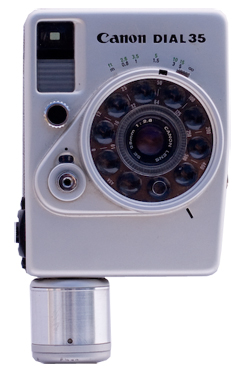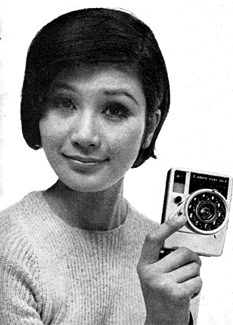
Format: 35mm Half-Frame
Approx. date of manufacture: 1963
Approx. original price: $80
Approx. street value: low
Original Battery:Mallory RM-1R (1.3V)
This is one of Canon's more interesting experiments. It's the half-frame format, which makes the camera smaller and lighter, and it made the spring-driven motor drive a practical application.
I'm not going to go into the half-frame stuff; you can read more about that on my Demi S page.
What makes this camera interesting are two things; the first is the bubble-dial around the lens that gives the camera its name; to set the film speed, you press on the bubbles and it rotates. The ASA/ISO speeds are marked in-between each bubble; in the camera photo here, I've got the camera set at ASA 50/64.
The other important feature is that big, round knob on the bottom. That can be rotated to load up a spring; when the shutter is tripped, the spring advances the film. Being a half-frame vertical format seriously cuts down the length of film that has to be wound each time, so they didn't have to have a huge spring, or make the knob difficult to wind.
 The original battery was a Mallory RM-1R, which is a 1.3V cell. The modern "equivalent" is an A1PX, aka an LR50, which run at 1.5V. For this reason the meter is going to read incorrectly; you're going to have to check it against a meter or camera you know is accurate and adjust the ASA until the meters agree. So for instance, you may find that the Dial35 needs to be set at ASA 50 even though you're using ASA (ISO) 100 film in order to get the meter to read properly.
The original battery was a Mallory RM-1R, which is a 1.3V cell. The modern "equivalent" is an A1PX, aka an LR50, which run at 1.5V. For this reason the meter is going to read incorrectly; you're going to have to check it against a meter or camera you know is accurate and adjust the ASA until the meters agree. So for instance, you may find that the Dial35 needs to be set at ASA 50 even though you're using ASA (ISO) 100 film in order to get the meter to read properly.
There's also a Dial35-2, which came out in 1968. The easiest way to spot it is that the Canon Dial35 marking and the focus scale were changed to white-on-black. Internally, they changed the meter to run off a 625 mercury battery. You can get a Wein cell modern equivalent for that one, or you can do the ASA adjustment I mentioned above and use a modern 625.
Modern Photography magazine, August 1978, included this camera in it's article 19 Used Camera Buys and 3 Dogs to Avoid. This was #1 on the dog list. Just to prove that even a "prestige" manufacturer of 35mm equipment can produce a mini-disaster, herewith the Canon Dial, a half-frame, spring-motor-drive, scale focusing camera with a very good quality 28mm ƒ/2.8 Canon lens. Although the Dial has a decent viewfinder, is easy to hand-hold, is reasonably pocketable despite its unusual shape, and is capable of accurate auto-exposures using the shutter-preferred system, it has two failings—one minor and one major. First, you've got to turn the camera upsidedown to set shutter speeds (1/30-1/250), and the camera is notorious for its mechanical unreliability. Still, if you're going to Sweden pick one up--the Swedes reportedly love 'em and are willing to pay a premium price for one in reasonable shape!
For more information: Canon Camera Museum
Camera manual: Orphan Cameras.com



